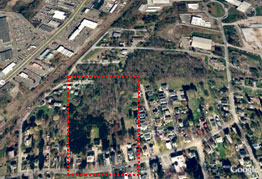Daryl LaFleur recently posted the following to Paradise City Forum. He has kindly given us permission to reprint it here. We have added emphasis to certain passages.
The North Street neighborhood residential development as proposed by Mr. Kohl presents Northampton with a unique in-town development opportunity. While I often read entries on the PCF that use terms like sustainability, smart growth, infill and the like, the importance of maintaining the ecology of our urban ecosystem often seems under represented. The North Street Neighborhood Association’s weblog is a great resource to learn more about the benefits of maintaining our urban ecological infrastructure and provides an opportunity to engage the neighborhood in a productive discourse. www.northassoc.org.
The University of Massachusetts offers an interdisciplinary graduate level course in Urban-suburban Ecology and Wildlife Management and located in the university’s library are many peer reviewed journal articles on the topic. If birds, small mammals, amphibians, insects and their corresponding flora could attend public hearings to make a case for their urban habitat preservation I’m sure they would. ;^) Otherwise, how are we to know the current status of wildlife population densities in these areas? If the North Street area’s ecological footprint is diminished and part of an unsealed natural habitat is removed, where will the wildlife migrate to and how does that migration impact species richness as well as other neighborhoods?
Constructing homes in the downtown area near existing services, infrastructure and public transit makes sense. However, the Urban Land Institute’s report on Springfield [PDF] suggests removing decaying buildings and creating more green spaces in Springfield’s downtown area as a way to enhance that city’s quality of life and lure people back to downtown. Springfield would like to create, on a larger scale, what Northampton currently has and one need only walk around downtown Springfield and observe the lack of urban green patches to understand why. Similarly, despite all of its problems, the Big Dig in Boston aims to add parkland and green recreational areas in an urban environment for the same reason, to improve the quality of life for inhabitants and give business owners a reason to stay put.
Traffic concerns aside, this residential subdivision proposal represents a single-use albeit tightly clustered sprawl-like development that on paper is quite different in appearance from the existing neighborhood. This is not unlike Hockanum Road where the city recently permitted the installation of fourteen three-story row houses in a neighborhood that consisted mostly of single-family homes.
Here is a sample of links on urban ecology from a web search that found over four million results:
www.urbanecology.org/
www.bc.edu/bc_org/research/urbaneco/
www.urbaneco.washington.edu/
www.urbanecology.washington.edu/
www.yale.edu/hixon/
www.ecostudies.org/IES_urban_ecology_why.html
See also:
Kohl’s Condo Proposal: Where Things Stand and What You Can Do
Surrounded by developed areas on all sides, our forest is one of the few substantial stands of trees in downtown Northampton. A distinctive and beautiful feature of our neighborhood, the forest cools the air, buffers sound from I-91 and King Street, smells great, absorbs water, and provides a habitat for deer and small animals of all kinds…

A wetland centered on Millyard Brook runs through the heart of the forest. The buffer area around a wetland is important in itself, an edge zone of high species diversity that helps regulate water flows into the wetland. These areas are fragile, can take a long time to establish, and are easily disturbed by development. The consequences of development around wetlands are often increased flooding in wet periods and more severe dryness during droughts.
Urban ‘infill’ development is laudable when it reclaims parking lots, brownfields and decayed structures. However, Kohl’s proposal will impact substantial amounts of natural green space, in conflict with the ecological goals of Northampton’s Sustainability Plan…